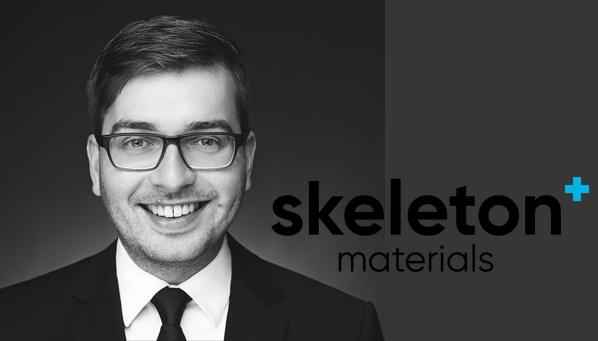Hi, my name is Markus. I am a Chemist by training with background in porous carbon materials for energy storage applications. Currently I am managing Skeletons efforts in the field of Intellectual Property – including our patenting activities – and I am also leading some technical projects on our side, such as the work on the GREENCAP-Project. My main focus is coordinating the work of our staff members involved here for scaling up the synthesis of our proprietary raw material “Curved Graphene”, while simultaneously increasing the product quality. For example, by reducing the content of impurities we aim to increase the lifetime of the prototype cells using our material. Another aspect is the incorporation of external feedback into our processes.
What was your original motivation to become a researcher?
I was always fascinated by the possibility of creating new things, both by coming up with completely new ideas, but also by combining already known items into something that did not exist before. Being a chemist, there is also a playful element to the work in the laboratory. Even though today’s technology is quite advanced in many aspects, one can still encounter effects that were not foreseen and which can open up new ways of advancing.
What is your (main) research area today?
At Skeleton Materials we are focusing on developing and scaling up the synthesis of Skeletons proprietary raw material “Curved Graphene”. Essentially, this is a porous carbon which provides several benefits especially for energy storage applications in comparison with conventional activated carbons. Using Curved Graphene more energy can be stored in the same volume which is a critical step for bringing supercapacitor technology into applications with strong spatial restrictions, such as in the automotive sector.
However, providing such a material in industrially relevant quantities is a major challenge, which requires numerous innovations in fields such as reactor design, material sciences and analytics. Luckily Skeleton has developed quite an extensive knowledge in this field over the past years, which is the basis for our current scale-up activities here.
What is the main objective of your team in GREENCAP?
Our main task is to provide our carbon material in amounts that are sufficient for producing prototype cells for high power energy storage. In that frame the material properties need to be adjusted based on the feedback of our project partners, in order to meet the targets of increased energy content, low resistance and facile integration into the electrode production process of the resulting energy storage cells. Of course, part of the objective is to design the material and related processes in a way that is also feasible from an economic perspective, which is important for transferring the results into final products.
What expertise and facilities does your team have to meet those objectives?
Skeleton Materials employs a team with a strong background knowledge in both material science as well as chemical industry. Our approach to the development here is a holistic one, which also involves the input of our simulation experts to pre-screen synthesis conditions in the reactor with respect to the expected material properties. This helps a lot in speeding up our R&D efforts. In our facilities we have a variety of reactors available, both for the base synthesis but also for the adjustment of the material surface properties, for example by treating it with different reactive gas atmospheres. We also can adjust the particle size distribution with our mills. For the characterization of the material, we have a specialized team of scientists that uses a variety of techniques such as gas adsorption for determination of porosity properties. Other aspects that we evaluate are densities and material purity.
Which aspects of your research at GREENCAP do you believe are the most innovative and what unique opportunities offer GREENCAP to yourself and/or your organisation?
The interesting approach in GREENCAP is that it includes several innovative approaches and aims to combine them. From an electrochemical perspective, the use of ionic liquids in combination with tailored porous materials such as Curved Graphene is very promising. Furthermore, looking at the activities of our partners involving MXenes – including providing increased amounts thereof – are a significant contribution towards moving that topic out of the academic field and into the prototype phase.
For us it is exciting to collaborate with partners that provide an extensive knowledge of advanced material characterization techniques. As a company we typically do not focus on employing high-end analysis techniques such as, for example HRTEM or XPS. We believe that we can gain valuable insights by employing these methods onto the new materials in this project.
How do you see the future use of the GREENCAP-results and the impact of GREENCAP-project in our daily lives?
The GREENCAP-results can potentially have quite a significant impact on our lives and for our societies as a whole. This, in particular of course in the field of energy storage with increased amounts of energy being stored in given volumes, thereby facilitating the overall trend towards electrification. Also, by employing low-resistance high-end materials the lifetime of the corresponding systems can be increased. This overall reduces the carbon footprint thereof and hence also enables a more sustainable infrastructure. This in turn is also expected to yield lower cost in the long run. Also, we expect advancements in the field of material science and characterization possibly trigger new developments for novel composite materials that can then also be explored in different fields such as sensing or catalysis.

